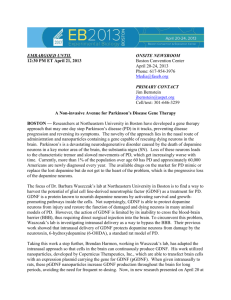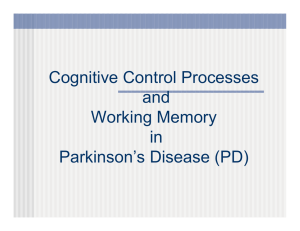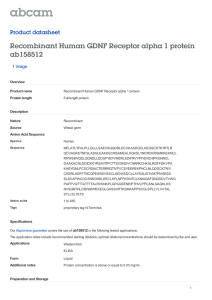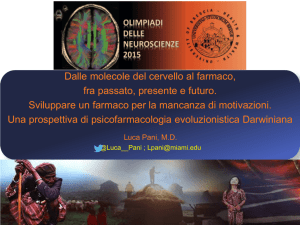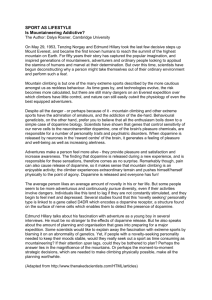Long-term glial cell line-derived neurotrophic factor overexpression
advertisement
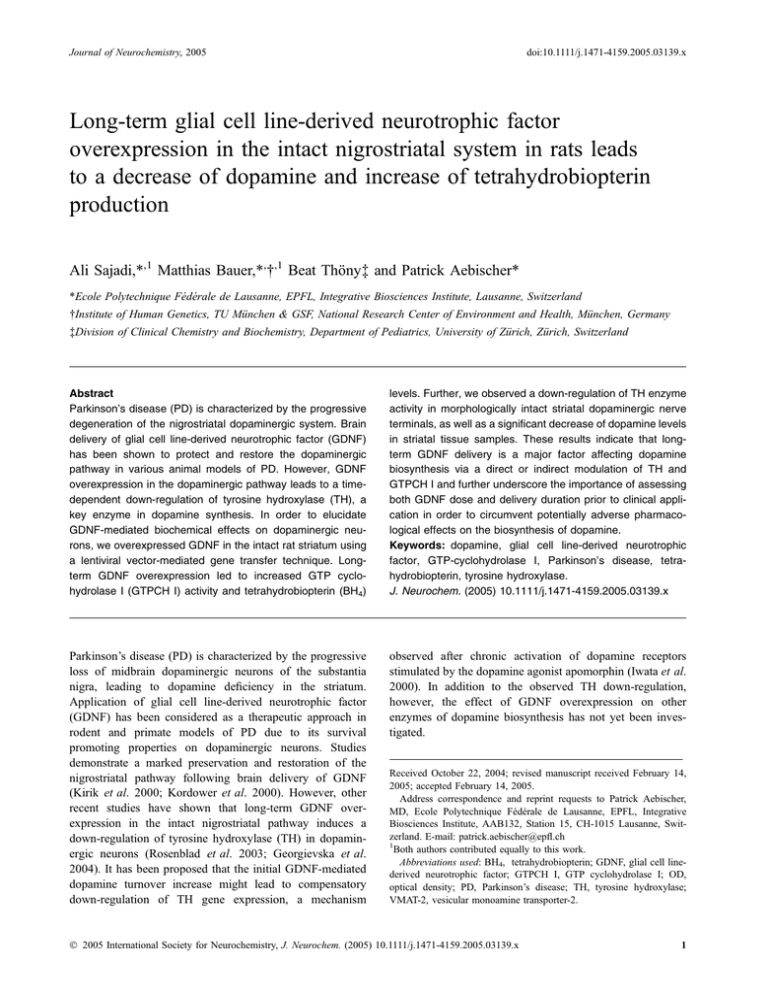
Journal of Neurochemistry, 2005 doi:10.1111/j.1471-4159.2005.03139.x Long-term glial cell line-derived neurotrophic factor overexpression in the intact nigrostriatal system in rats leads to a decrease of dopamine and increase of tetrahydrobiopterin production Ali Sajadi,*,1 Matthias Bauer,*, ,1 Beat Thönyà and Patrick Aebischer* *Ecole Polytechnique Fédérale de Lausanne, EPFL, Integrative Biosciences Institute, Lausanne, Switzerland Institute of Human Genetics, TU München & GSF, National Research Center of Environment and Health, München, Germany àDivision of Clinical Chemistry and Biochemistry, Department of Pediatrics, University of Zürich, Zürich, Switzerland Abstract Parkinson’s disease (PD) is characterized by the progressive degeneration of the nigrostriatal dopaminergic system. Brain delivery of glial cell line-derived neurotrophic factor (GDNF) has been shown to protect and restore the dopaminergic pathway in various animal models of PD. However, GDNF overexpression in the dopaminergic pathway leads to a timedependent down-regulation of tyrosine hydroxylase (TH), a key enzyme in dopamine synthesis. In order to elucidate GDNF-mediated biochemical effects on dopaminergic neurons, we overexpressed GDNF in the intact rat striatum using a lentiviral vector-mediated gene transfer technique. Longterm GDNF overexpression led to increased GTP cyclohydrolase I (GTPCH I) activity and tetrahydrobiopterin (BH4) levels. Further, we observed a down-regulation of TH enzyme activity in morphologically intact striatal dopaminergic nerve terminals, as well as a significant decrease of dopamine levels in striatal tissue samples. These results indicate that longterm GDNF delivery is a major factor affecting dopamine biosynthesis via a direct or indirect modulation of TH and GTPCH I and further underscore the importance of assessing both GDNF dose and delivery duration prior to clinical application in order to circumvent potentially adverse pharmacological effects on the biosynthesis of dopamine. Keywords: dopamine, glial cell line-derived neurotrophic factor, GTP-cyclohydrolase I, Parkinson’s disease, tetrahydrobiopterin, tyrosine hydroxylase. J. Neurochem. (2005) 10.1111/j.1471-4159.2005.03139.x Parkinson’s disease (PD) is characterized by the progressive loss of midbrain dopaminergic neurons of the substantia nigra, leading to dopamine deficiency in the striatum. Application of glial cell line-derived neurotrophic factor (GDNF) has been considered as a therapeutic approach in rodent and primate models of PD due to its survival promoting properties on dopaminergic neurons. Studies demonstrate a marked preservation and restoration of the nigrostriatal pathway following brain delivery of GDNF (Kirik et al. 2000; Kordower et al. 2000). However, other recent studies have shown that long-term GDNF overexpression in the intact nigrostriatal pathway induces a down-regulation of tyrosine hydroxylase (TH) in dopaminergic neurons (Rosenblad et al. 2003; Georgievska et al. 2004). It has been proposed that the initial GDNF-mediated dopamine turnover increase might lead to compensatory down-regulation of TH gene expression, a mechanism observed after chronic activation of dopamine receptors stimulated by the dopamine agonist apomorphin (Iwata et al. 2000). In addition to the observed TH down-regulation, however, the effect of GDNF overexpression on other enzymes of dopamine biosynthesis has not yet been investigated. Received October 22, 2004; revised manuscript received February 14, 2005; accepted February 14, 2005. Address correspondence and reprint requests to Patrick Aebischer, MD, Ecole Polytechnique Fédérale de Lausanne, EPFL, Integrative Biosciences Institute, AAB132, Station 15, CH-1015 Lausanne, Switzerland. E-mail: patrick.aebischer@epfl.ch 1 Both authors contributed equally to this work. Abbreviations used: BH4, tetrahydrobiopterin; GDNF, glial cell linederived neurotrophic factor; GTPCH I, GTP cyclohydrolase I; OD, optical density; PD, Parkinson’s disease; TH, tyrosine hydroxylase; VMAT-2, vesicular monoamine transporter-2. Ó 2005 International Society for Neurochemistry, J. Neurochem. (2005) 10.1111/j.1471-4159.2005.03139.x 1 2 A. Sajadi et al. The present study was aimed at investigating GDNFmediated biochemical effects on dopaminergic neurons in vivo, using a lentiviral vector-mediated gene transfer technique, in order to overexpress GDNF in rat striatum. Three months post-viral vector application, samples of striatal tissue were subjected to the following analysis: (i) immunohistochemistry for TH and vesicular monoamine transporter-2 (VMAT-2), (ii) enzyme activity measurements for TH and GTP cyclohydrolase I (GTPCH I), the ratelimiting enzyme of tetrahydrobiopterin (BH4) synthesis and (iii) measurements of dopamine and BH4, a cofactor of TH. Materials and methods Animals Adult female Sprague-Dawley rats (n ¼ 18; Charles River Laboratories 69592 L’Arbresle, France) were housed in a specific pathogen-free facility under controlled temperature and humidity, with a standardized 12 : 12 h, light : dark cycle and were provided with food and water ad libitum. The experiments were carried out in accordance with the European Community Council Directive (86/ 609/EEC) for care and use of laboratory animals. Lentiviral vector production GDNF (lenti-GDNF) and control-mutated GDNF (lenti-muGDNF) expressing viral vectors were produced from a four-plasmid system, as previously described (Bensadoun et al. 2000). Surgery All viral vector injections were performed using a 10-lL Hamilton syringe with a 33-gauge blunt tip needle mounted on a stereotaxic frame (Kopf, Tujunga, CA, USA). Under ketamine/xylazine anesthesia, 2 lL of a 100 000 ng p24 antigen/mL lentiviral stock was injected bilaterally at two different sites per striatum. Injections were performed at the following coordinates in mm with reference to bregma (according to the atlas of Paxinos and Watson): (i) AP 1, LAT ±3, V )6.2; (ii) AP 0, LAT ±3.8, V )6.2. The tooth bar was set at )2.5 mm for all coordinates. The speed of injection was 0.4 lL/min. The syringe was retracted by 1 mm after the injection and left in place for an additional 4 min at each site before being slowly withdrawn. Eight rats were injected with the lenti-GDNF and eight with the lenti-muGDNF viruses. Two animals did not receive viral vector injections and served as sentinel controls. Immunohistochemistry Tissue processing Three months after viral vector injections, four rats from the lentiGDNF and four from the lenti-muGDNF groups were killed and their brains processed for immunohistochemistry as previously described (Regulier et al. 2002). Glial cell line-derived neurotrophic factor and tyrosine hydroxylase stainings GDNF and TH stainings were performed using anti-human GDNF and anti-TH antibodies as previously described (Hottinger et al. 2000; Sajadi et al. 2004). Vesicular monoamine transporter-2 staining Slices were quenched as for the TH staining before being incubated overnight at 4°C in a blocking solution of 10% normal goat serum (Invitrogen Corporation, Carlsbad, CA, USA) and 0.1% triton X-100. Slices were incubated overnight with rabbit polyclonal antiVMAT-2 antibodies (1 : 2000; Chemicon AB1767, Temecula, CA, USA) in the blocking buffer. They were incubated for 1 h with biotinylated goat anti-rabbit immunoglobulins (1 : 200; Vector Laboratories, Burlingame, CA, USA) and 1% normal goat serum at 4°C, before being incubated in avidin–biotin–peroxidase solution for 30 min. Slices were finally revealed with diminobenzidine and mounted onto gelatinized glass slides. Striatal fiber density measurements Immunostained sections of the striatum were scanned and optical densities (ODs) of the TH and VMAT-2-positive fibers in the striatum were measured using the NIH 1.62 Image program. For each animal, the ODs were measured bilaterally at three different AP coordinates: (i) 0.7; (ii) )0.3; (iii) )1.3 (in mm according to the bregma), with correction for non-specific background. The mean between right and left (R/L) striatal ODs was calculated per coordinate for each animal and the mean value was calculated per coordinate for both groups. Biochemical analysis Three months after viral vector injections, four rats each from the lenti-GDNF and lenti-muGDNF groups, as well as two non-injected rats, were killed by an overdose of pentobarbital and perfused transcardially with a phosphate-buffered solution. A 3-mm thick coronal brain slice was obtained at the mid-striatum level using a tissue slicer (Stoelting Co, Wood Dale, IL, USA). A 1.75-mm diameter punch was taken from the striatum bilaterally for further biochemical investigation. TH activity measurements were performed under saturating substrate and cofactor conditions basically as described previously (Flatmark et al. 1999), followed by an aluminium-oxide acid (ALOX, Sigma, St Louis, MO, USA) purification step and HPLC quantification (Nagatsu et al. 1979). GTPCH I activity measurements and measurements of striatal BH4 levels were performed as described by Elzaouk et al. (2003). Tissue dopamine levels were determined according to the method described by Blau et al. (1999). Statistical analysis Comparisons of the TH and VMAT-2 ODs were performed using a Student’s t-test at each coordinate. Enzyme activity, BH4 levels and dopamine content measurements were analyzed using a one-way analysis of variance (ANOVA) followed by a Newman–Keuls post hoc test. The significance level was set at p < 0.05. Data are expressed as mean ± SEM. Results Immunohistochemical studies at 3 months following lentiviral vector injections for TH and VMAT-2 to assess GDNFinduced effects on these dopaminergic-specific markers (Fig. 1) revealed a significant decrease in the striatal TH staining density in the lenti-GDNF group as compared to the lenti-muGDNF group (p < 0.01 at 0.7 and )1.3 mm; Ó 2005 International Society for Neurochemistry, J. Neurochem. (2005) 10.1111/j.1471-4159.2005.03139.x GDNF effects on dopaminergic neurons 3 Fig. 2 Biochemical measurements in the striatum 3 months postlentiviral vector injections. (A) A highly significant increase was observed in GTP cyclohydrolase I (GTPCH I) activity in the lenti-glial cell line-derived neurotrophic factor (lenti-GDNF) group as compared to the lenti-muGDNF and non-injected groups (***p < 0.001). (b) A highly significant increase was observed in tetrahydrobiopterin (BH4) levels in the lenti-GDNF group as compared to the lenti-muGDNF and non-injected groups (***p < 0.001). (c) A significant decrease of tyrosine hydroxylase (TH) activity was observed in the lenti-GDNF group as compared to the lenti-muGDNF and non-injected groups (*p < 0.05). (d) A significant decrease was observed in dopamine levels in the lenti-GDNF group as compared to the lenti-muGDNF and non-injected groups (*p < 0.05). Fig. 1 Tyrosine hydroxylase (TH), vesicular monoamine transporter-2 (VMAT-2) and glial cell line-derived neurotrophic factor (GDNF) immunostainings in the striatum 3 months post-lentiviral vector injections. (a) Decreased density of TH staining in a lenti-GDNF as compared to a lenti-muGDNF injected rat. No difference for the VMAT-2 staining was observed between both animals. GDNF was detected only in the lenti-GDNF animal. (b) Quantification of the density of TH and VMAT-2 striatal stainings revealing a significant decrease of the density of TH staining in the lenti-GDNF group as compared to the lenti-muGDNF group (**p < 0.01 at 0.7 and )1.3 mm; ***p < 0.001 at )0.3 mm), but no significant difference for the VMAT-2 staining between both groups. p < 0.001 at )0.3 mm). In contrast, no significant differences were found in VMAT-2 immunostaining levels between both vector groups. In accordance with these findings, measurements of enzymatic TH activity were also significantly decreased in the lenti-GDNF group as compared to lenti-muGDNF and non-injected controls (p < 0.05) (Fig. 2c). As further assessment of the biochemical effects of GDNF, enzymatic GTPCH I activity and BH4 levels were measured in striatal samples (Figs 2a and b). Highly significant increases in both GTPCH I activity and BH4 levels were observed in lenti-GDNF treated rats as compared to lentimuGDNF and non-injected controls (p < 0.001). GDNF-induced dopamine neurotransmitter changes were also evaluated 3 months post-lentiviral vector injections (Fig. 2d). Notably, we found significantly lowered striatal dopamine levels in the lenti-GDNF group as compared to the lenti-muGDNF and non-injected groups (p < 0.05). Discussion These results demonstrate that long-term striatal lentiviral vector-mediated GDNF overexpression leads to decreased TH immunoreactivity in the intact rodent striatum and confirms effects in the intact as well as in the lesioned nigrostriatal dopamine system already reported by others (Georgievska et al. 2002, 2004; Rosenblad et al. 2003). In addition, our study shows that TH protein down-regulation is also associated with an overall decrease in its activity. The sustained VMAT-2 immunoreactivity in the present study and in that of Georgievska et al. (2004) provides strong evidence for the morphological integrity of the nigrostriatal pathway. We therefore conclude that TH down-regulation is related to direct and/or indirect GDNF-induced effects on its expression. In contrast to TH activity, we found increases in both GTPCH I activity and BH4 levels following GDNF delivery in the striatum. We hypothesize that the increase in BH4 Ó 2005 International Society for Neurochemistry, J. Neurochem. (2005) 10.1111/j.1471-4159.2005.03139.x 4 A. Sajadi et al. levels is mediated by GDNF, as the up-regulation of pterine biosynthesis after GDNF treatment has also been shown in vitro (Bauer et al. 2002). Moreover, cresyl violet staining did not suggest an ongoing inflammatory response after lentiviral injections in the striatum (data not shown). The neuronal concentration of BH4 in rat brain is 100 lM, whereas the Km for BH4 of non-phosphorylated TH is 500 lM (Levine et al. 1981). As non-phosphorylated TH accounts for approximately 80% of total brain TH, the observed twofold increase in BH4 induced by GDNF overexpression in the striatum should increase TH activity, potentially leading to an increase in dopamine production (Miwa et al. 1985). Already reported increases in dopamine turnover following GDNF delivery might be therefore due to increased cofactor production (Hudson et al. 1995; Georgievska et al. 2004). In turn, chronically elevated striatal dopamine levels and dopamine receptor stimulation results in down-regulation of TH-mRNA (Iwata et al. 2000), as negative feedback control to normalize the dopaminergic input in this highly regulated system. Strikingly, dopamine levels in our study were significantly decreased, suggesting either a rather slow adaptation of the system with transient overcompensation or involvement of a more direct regulation of TH transcription and pterine biosynthesis through distinct GDNF signaling pathways, irrespective of striatal neurotransmitter levels. Nevertheless, analysis of known regulatory sequences in the TH promoter region provides no further insights into the nature of direct TH down-regulation (Kumer and Vrana 1996), as two known responsive elements also comprising the GDNF signaling cascade increase rather than decrease TH-mRNA transcription (Takahashi 2001). The observed decrease in striatal dopamine levels is indeed intriguing. Georgievska et al. (2004) have shown stable dopamine levels in this brain region following longterm GDNF overexpression, despite TH-enzyme downregulation. In contrast, we have observed a significant reduction in dopamine levels 3 months following GDNF overexpression. These discrepancies may be explained in part by varying levels of GDNF expression. In contrast to our rodent study, primate studies have shown an increase in dopamine and dopamine metabolites followed by chronic intraputaminal GDNF delivery in lesioned and aged monkeys (Kordower et al. 2000; Ai et al. 2003). Increased levels of dopamine and TH, however, have been accompanied by a significant increase of the number of TH-expressing neurons and morphological changes such as increased perikaryon size and enhanced fiber outgrowth, which per se could lead to an overall change in metabolites and enzyme activity measurements. Thus, further studies in primates with an intact nigrostriatal system as well as in primate models of PD will have to evaluate the impact of our findings. Taken together, our data show significant effects of longterm GDNF treatment on dopamine metabolism of dopaminergic neurons in vivo, resulting in significant decreases of striatal dopamine levels. Our findings may have a considerable impact on the therapeutic use of GDNF: dose and treatment duration will have to be established and optimized with the aim of achieving beneficial neuroprotective effects of the trophic factor while circumventing undesirable pharmacologic effects on dopamine biosynthesis. Acknowledgements The authors thank Philippe Colin for his expert technical assistance and Walter Leimbacher for excellent technical work. This work was supported by the Swiss National Science Foundation and by the Deutsche Forschungsgemeinschaft (DFG BA 2250/1–1 to MB). References Ai Y., Markesbery W., Zhang Z., Gordin R., Elseeberry D., Gerhardt G. A. and Gash D. M. (2003) Intraputaminal infusion of GDNF in aged rhesus monkeys: distribution and dopaminergic effects. J. Comp. Neurol. 461, 250–261. Bauer M., Suppmann S., Meyer M., Hesslinger C., Gasser T., Widmer H. R. and Ueffing M. (2002) Glial cell line-derived neurotrophic factor up-regulates GTP-cyclohydrolase I activity and tetrahydrobiopterin levels in primary dopaminergic neurones. J. Neurochem. 82, 1300–1310. Bensadoun J. C., Deglon N., Tseng J. L., Ridet J. L., Zurn A. D. and Aebischer P. (2000) Lentiviral vectors as a gene delivery system in the mouse midbrain: cellular and behavioral improvements in a 6-OHDA model of Parkinson’s disease using GDNF. Exp. Neurol. 164, 15–24. Blau N., Thony B., Renneberg A., Penzien J. M., Hyland K. and Hoffmann G. F. (1999) Variant of dihydropteridine reductase deficiency without hyperphenylalaninaemia: effect of oral phenylalanine loading. J. Inherit. Metab. Dis. 22, 216–220. Elzaouk L., Leimbacher W., Turri M., Ledermann B., Burki K., Blau N. and Thony B. (2003) Dwarfism and low insulin-like growth factor1 due to dopamine depletion in Pts–/– mice rescued by feeding neurotransmitter precursors and H4-biopterin. J. Biol. Chem. 278, 28 303–28 311. Flatmark T., Almas B., Knappskog P. M., Berge S. V., Svebak R. M., Chehin R., Muga A. and Martinez A. (1999) Tyrosine hydroxylase binds tetrahydrobiopterin cofactor with negative cooperativity, as shown by kinetic analyses and surface plasmon resonance detection. Eur. J. Biochem. 262, 840–849. Georgievska B., Kirik D. and Bjorklund A. (2002) Aberrant sprouting and downregulation of tyrosine hydroxylase in lesioned nigrostriatal dopamine neurons induced by long-lasting overexpression of glial cell line derived neurotrophic factor in the striatum by lentiviral gene transfer. Exp. Neurol. 177, 461–474. Georgievska B., Kirik D. and Bjorklund A. (2004) Overexpression of glial cell line-derived neurotrophic factor using a lentiviral vector induces time- and dose-dependent downregulation of tyrosine hydroxylase in the intact nigrostriatal dopamine system. J. Neurosci. 24, 6437–6445. Hottinger A. F., Azzouz M., Deglon N., Aebischer P. and Zurn A. D. (2000) Complete and long-term rescue of lesioned adult motoneurons by lentiviral-mediated expression of glial cell line-derived neurotrophic factor in the facial nucleus. J. Neurosci. 20, 5587–5593. Hudson J., Granholm A. C., Gerhardt G. A. et al. (1995) Glial cell linederived neurotrophic factor augments midbrain dopaminergic circuits in vivo. Brain Res. Bull. 36, 425–432. Ó 2005 International Society for Neurochemistry, J. Neurochem. (2005) 10.1111/j.1471-4159.2005.03139.x GDNF effects on dopaminergic neurons 5 Iwata S., Nomoto M., Kaseda S., Tanoue S., Shimosaka M. and Fukuda T. (2000) TH protein and mRNA in nigrostriatal dopaminergic neurons are down-regulated by continuous but not intermittent apomorphine. Brain Res. Mol. Brain Res. 82, 133–136. Kirik D., Rosenblad C., Bjorklund A. and Mandel R. J. (2000) Longterm rAAV-mediated gene transfer of GDNF in the rat Parkinson’s model: intrastriatal but not intranigral transduction promotes functional regeneration in the lesioned nigrostriatal system. J. Neurosci. 20, 4686–4700. Kordower J. H., Emborg M. E., Bloch J. et al. (2000) Neurodegeneration prevented by lentiviral vector delivery of GDNF in primate models of Parkinson’s disease. Science 290, 767–773. Kumer S. C. and Vrana K. E. (1996) Intricate regulation of tyrosine hydroxylase activity and gene expression. J. Neurochem. 67, 443–462. Levine R. A., Miller L. P. and Lovenberg W. (1981) Tetrahydrobiopterin in striatum: localization in dopamine nerve terminals and role in catecholamine synthesis. Science 214, 919–921. Miwa S., Watanabe Y. and Hayaishi O. (1985) 6R-L-erythro-5,6,7, 8-tetrahydrobiopterin as a regulator of dopamine and serotonin biosynthesis in the rat brain. Arch. Biochem. Biophys. 239, 234– 241. Nagatsu T., Oka K., Numata Y. and Kato T. (1979) A simple and sensitive fluorescence assay for tyrosine hydroxylase activity. Anal. Biochem. 93, 82–87. Regulier E., Pereira de Almeida L., Sommer B., Aebischer P. and Deglon N. (2002) Dose-dependent neuroprotective effect of ciliary neurotrophic factor delivered via tetracycline-regulated lentiviral vectors in the quinolinic acid rat model of Huntington’s disease. Hum. Gene Ther. 13, 1981–1990. Rosenblad C., Georgievska B. and Kirik D. (2003) Long-term striatal overexpression of GDNF selectively downregulates tyrosine hydroxylase in the intact nigrostriatal dopamine system. Eur. J. Neurosci. 17, 260–270. Sajadi A., Schneider B. L. and Aebischer P. (2004) Wlds-mediated protection of dopaminergic fibers in an animal model of Parkinson disease. Curr. Biol. 14, 326–330. Takahashi M. (2001) The GDNF/RET signaling pathway and human diseases. Cytokine Growth Factor Rev. 12, 361–373. Ó 2005 International Society for Neurochemistry, J. Neurochem. (2005) 10.1111/j.1471-4159.2005.03139.x
